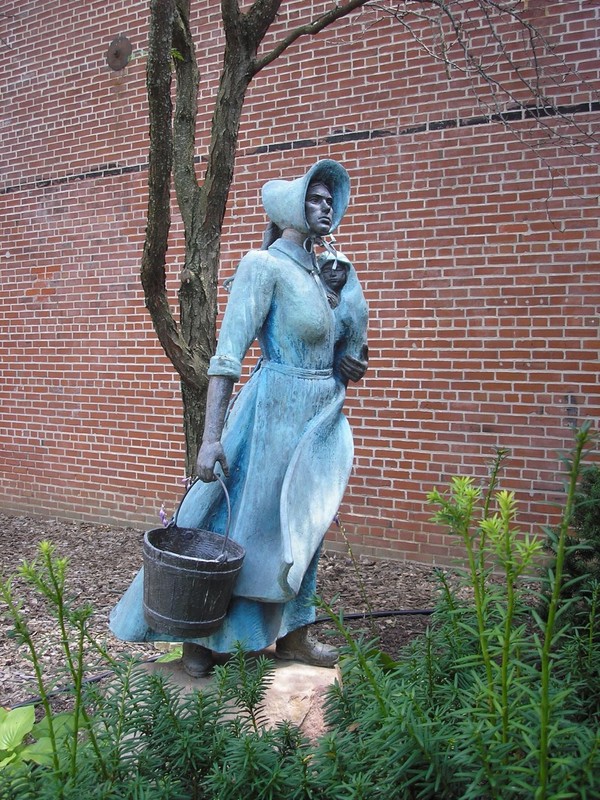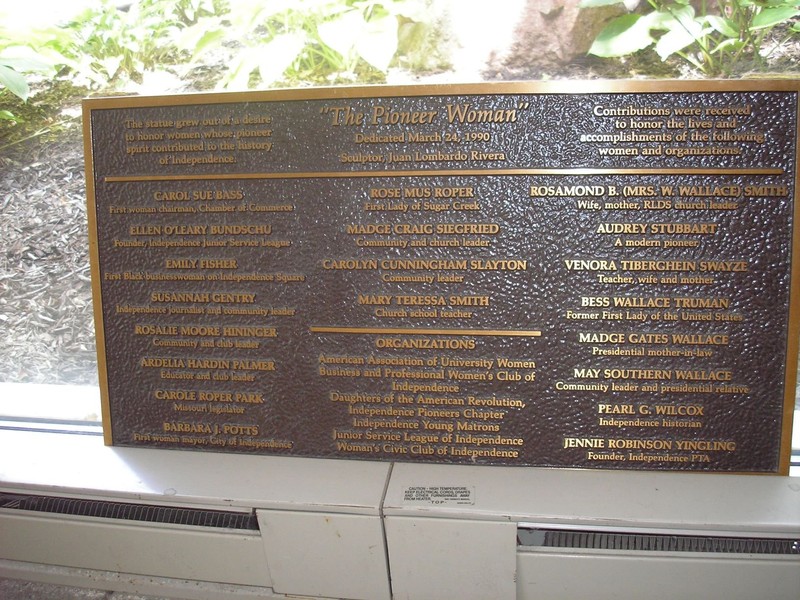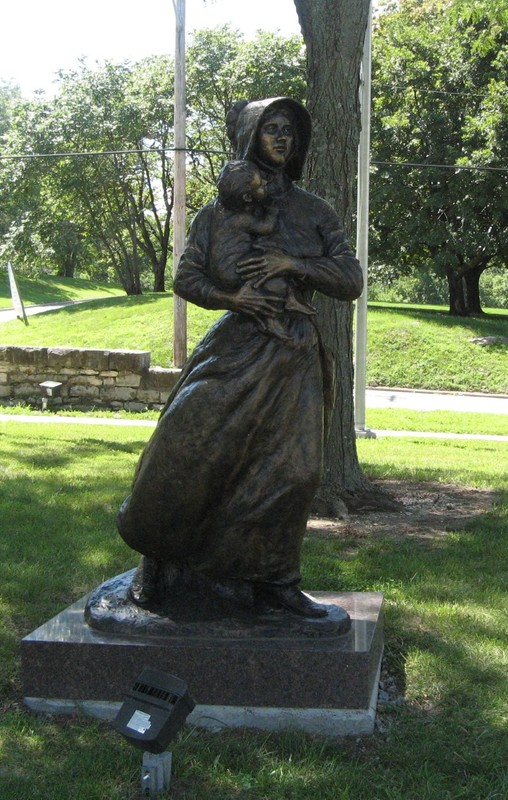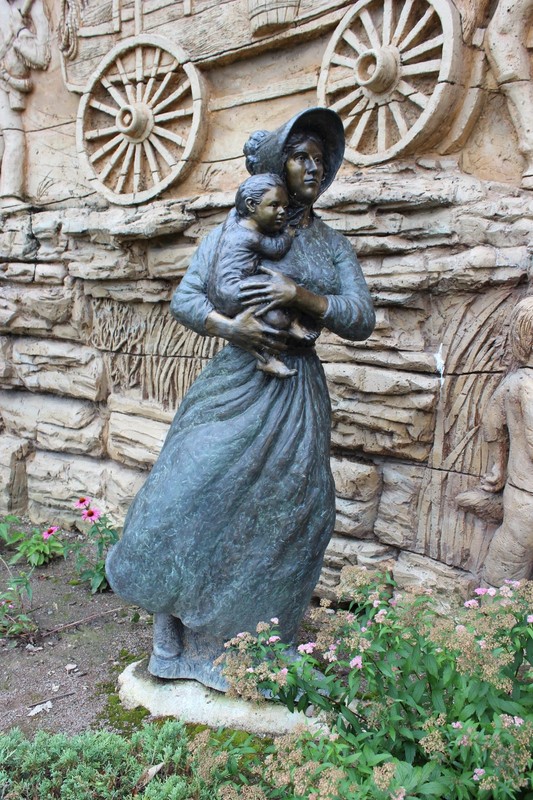Pioneer Woman statue (National Frontier Trails Museum)
Introduction
Text-to-speech Audio
Images
Juan Lombardo-Rivera, Pioneer Woman, 1990. Photo by Cynthia Prescott.

Plaque for 1990 Lombardo-Rivera Pioneer Woman statue. Photo by Cynthia Prescott.

Charles Goslin, Pioneer Woman, 2016. Photo by David Prescott.

Compare this 2006 Charles Goslin pioneer woman in Shawnee, KS, to the one he sculpted for Independence, MO. Photo by Cynthia Prescott.

Backstory and Context
Text-to-speech Audio
A Pioneer Woman statue by Mexican sculptor Juan Lombardo-Rivera was placed in the courtyard of the National Frontier Trails Museum when it opened in 1990. In 2013 that sculpture was stolen from the museum. The thieves took apart the statue and tried to sell it for scrap. It was replaced by this statue by local artist Charles Goslin in 2016. The new sculpture closely resembles the original statue, but with some important differences.
A Pioneer Woman statue by Mexican sculptor Juan Lombardo-Rivera was placed in the courtyard of the National Frontier Trails Museum when it opened in 1990. It symbolized the hope and grit of women who migrated west along the overland trails in the mid-19th century. It also honored women who pioneered in other ways, breaking gender barriers in recent decades.
Lombardo-Rivera’s statue was modeled after a local teenager, Theresa Brown. The life-sized bronze statue depicted a woman wearing a blue dress and sunbonnet. She carried a baby in one arm and a bucket in the other.
At the time, some on the statue fundraising committee feared that the blue patina that the Mexican artist applied to the statue was too vivid. But once it was installed in the courtyard, Independence residents soon warmed to the work.
In 2013 vandals stole the $35,000 Pioneer Woman statue, broke it to pieces and tried to sell it for scrap metal worth about $600. The Kansas City recycler recognized the bronze pieces as artwork and refused to accept them for recycling. The three vandals were caught and convicted. Two were sent to prison, and one was given probation. The remains of the Lombardo-Rivera statue were not recovered. But a smaller model of the original statue remains inside the museum.
The city of Independence raised nearly $40,000 in private donations to replace the statue. The selection committee chose a new Pioneer Woman sculpture by local artist Charles Goslin that closely resembles the stolen statue. Both sculptors depicted determined young women gazing into the distance, with the wind blowing their long prairie-style dresses. The new statue was installed in January 2017.
Nonetheless, minor differences between the two sculptures reveal changing gender ideals. The new statue emphasizes the frontier mother’s nurturing role over her labor. Instead of carrying an empty bucket, the new Pioneer Woman cradles her baby with both arms. Whereas Lombardo-Rivera’s tiny infant faced out toward the viewer, Goslin depicted a somewhat older child gazing up at its mother’s face. The Mexican artist celebrated women’s hard work, wearing rolled-up sleeves and carrying a bucket. In contrast, the local artist’s new version keeps her arms covered in long sleeves. She does not hold any tools or do any productive work.
Charles Goslin’s design for the 2016 Pioneer Woman closely resembles another bronze pioneer mother and child that Goslin sculpted a decade earlier for a life-sized sculpture to accompany a stone wagon train relief in Pioneer Crossing Park in nearby Shawnee, Kansas. (Today, both Independence, Missouri, and Shawnee, Kansas, are suburbs of Kansas City.) Both Goslin pioneer mothers wear long dresses and carry young children as they walk westward. But the Shawnee pioneer woman also wears a child gazes forward, echoing its mother’s westward focus, rather than gazing up at her face. Goslin added blue patina to the Shawnee woman and child, as Juan Lombardo-Rivera did with the first Independence monument. That Goslin chose not to apply any color to the new bronze pioneer mother for Independence suggests that the local artist sought to avoid a controversy like that surrounding the earlier version. Or perhaps Goslin felt a patina was not necessary to make the statue stand out in its new, more secure location near the entrance to the National Frontier Trails Museum.
Sources
Burke, Charles. "Pioneer women praised." Independence Examiner October 10, 1988.
Wyman, Scott. "Panel split on statue coloring: Bonnet, dress have blue cast." Independence Examiner February 20, 1990.
Burke, Charles. "Statue's blue hue will be toned down." Independence Examiner March 08, 1990.
Stowell and Kasey Babbitt, Kerri. "Museum chooses replacement for original statue destroyed by vandals in Independence." fox4kc.com February 24, 2015. https://fox4kc.com/2015/02/24/museum-chooses-replacement-for-original-statue-destroyed-by-vandals-in-independence/. Accessed July 24, 2019.
Fox, Jeff. "She's back: A new Pioneer Woman statue stands at museum." Independence Examiner January 12, 2017.
Prescott, Cynthia Culver. Pioneer Mother Monuments: Constructing Cultural Memory. University of Oklahoma Press, 2019.
